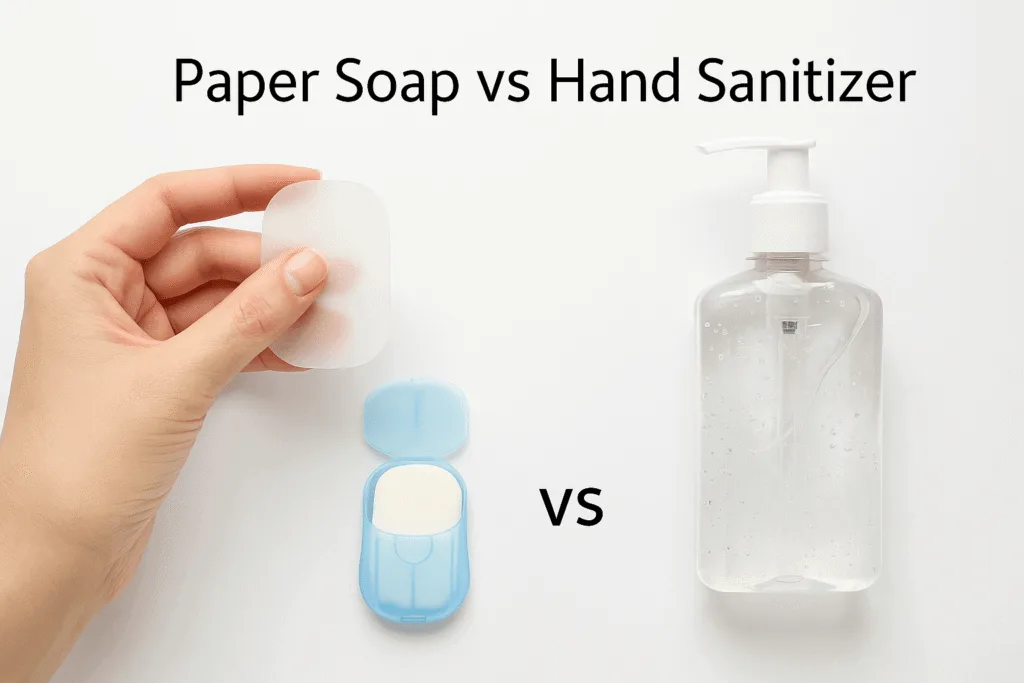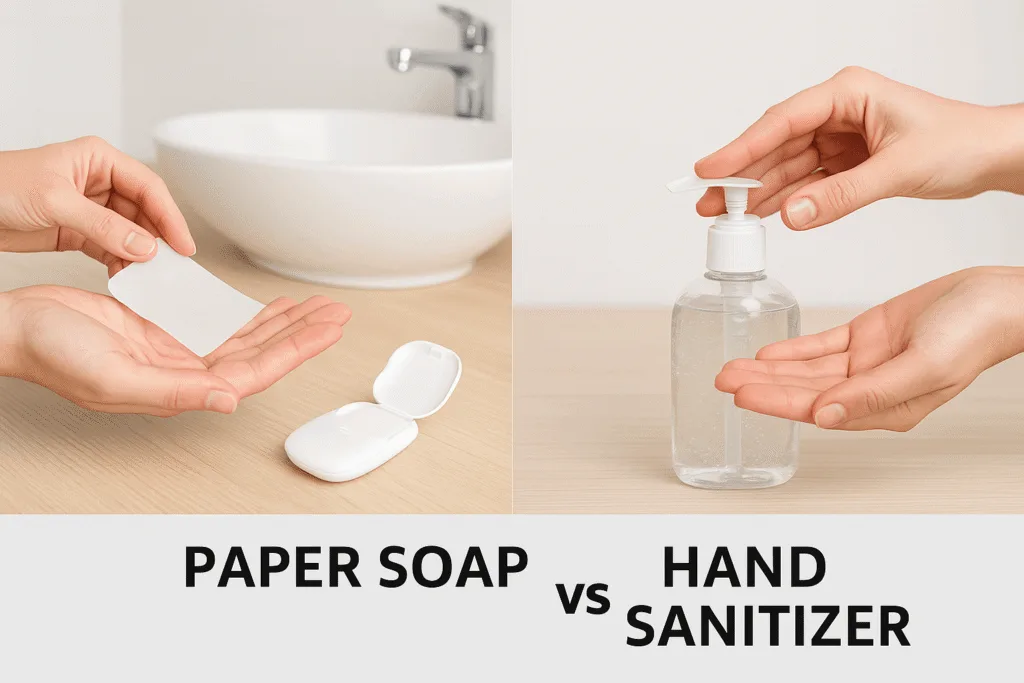In a world where hygiene is more important than ever, choosing the right cleaning products can feel overwhelming. Two popular options for on-the-go cleanliness are paper soap and hand sanitizer. While both aim to keep hands clean, they work differently and have distinct advantages. In this article, we’ll compare paper soap vs hand sanitizer, exploring their effectiveness, safety, and suitability for different situations—all while following Google SEO best practices.
What Are Paper Soap and Hand Sanitizer?
Let’s start with the basics: what exactly are these products, and how do they work?
Understanding Paper Soap
Paper soap, also known as soap paper, is an innovative product made from thin, biodegradable sheets infused with gentle soap formulas. When wet, these sheets lather like traditional soap, allowing you to wash hands thoroughly with water. They dissolve completely after use, leaving no residue, and come in compact, portable packaging. The portable soap alternative to bars, paper soap offers a mess-free way to cleanse hands without relying on liquid or bar soap. It’s ideal for situations where you want the thorough cleaning of soap but need something more travel-friendly.
How Hand Sanitizer Works
Hand sanitizer is a liquid or gel product typically containing alcohol (like ethanol or isopropyl alcohol) or antibacterial agents. It works by killing bacteria and some viruses on the skin without needing water. Users apply it by rubbing hands together until the product evaporates. While convenient, its effectiveness depends on alcohol concentration—most experts recommend at least 60% alcohol for proper disinfection. Unlike soap, it doesn’t physically remove dirt or grease, only deactivates some pathogens on the surface.
Effectiveness: Paper Soap vs Hand Sanitizer

When it comes to killing germs and removing dirt, these two products have different strengths.
When Paper Soap Shines
Paper soap excels at physically removing dirt, grease, and germs from hands. Unlike sanitizers that kill bacteria, soap breaks down oils and lifts contaminants, which are then rinsed away with water. This makes it more effective against certain tough pathogens, like norovirus or C. difficile, which hand sanitizer often struggles to eliminate. For outdoor activities or travel, the biodegradable soap paper for travel ensures you can wash hands thoroughly even when sinks are unavailable. Simply wet the sheet, lather, and rinse—no sticky residue, just clean hands.
When Hand Sanitizer Is Handy
Hand sanitizer shines in situations where water isn’t accessible and hands aren’t visibly dirty. It’s quick and convenient for killing common bacteria on the go, such as after touching public surfaces like doorknobs or elevator buttons. However, it’s less effective when hands are greasy, covered in dirt, or coated with organic matter (like food residue), as the alcohol can’t penetrate these substances as well. Overuse can also dry out skin due to its alcohol content, and the CDC notes that sanitizer should only be used when soap and water aren’t available.
Safety and Skin Health
Your skin’s health is a key factor in choosing between these products.
Paper Soap: Gentle and Eco-Friendly
Paper soap is generally safer for sensitive skin, as it’s often formulated with natural ingredients like plant-based surfactants, aloe vera, or glycerin—ingredients that cleanse gently without stripping the skin’s protective barrier. It avoids the harsh chemicals found in some sanitizers, such as triclosan or high alcohol concentrations that can cause dryness, redness, or irritation. The single-use soap sheets for public restrooms are also a hygienic choice, as each sheet is used once, eliminating the risk of cross-contamination from shared sanitizer bottles that multiple people touch.
Hand Sanitizer: Risks and Considerations
While effective when used correctly, hand sanitizer poses risks for certain groups. Young children may be tempted to swallow it, and those with alcohol allergies or sensitive skin may experience adverse reactions. The alcohol can also degrade the skin’s moisture barrier over time, leading to dry, cracked hands. Additionally, not all sanitizers are created equal: some contain harmful additives or insufficient alcohol levels, so choosing reputable brands and checking labels is crucial. The U.S. Food and Drug Administration (FDA) has repeatedly warned about contaminated sanitizers containing toxic ingredients like methanol, highlighting the importance of verifying product safety .
Convenience and Portability
For on-the-go lifestyles, convenience is king. Let’s see how these products stack up.

The On-the-Go Benefits of Paper Soap
Paper soap sheets are lightweight, dry, and easy to carry in pockets, purses, or backpacks. They don’t leak like liquid sanitizers, won’t melt in warm temperatures, and take up minimal space—perfect for travel, camping, or daily commutes. Their biodegradable nature also makes them an eco-friendly choice for outdoor enthusiasts who want to minimize waste. Whether you’re hiking a trail or navigating a busy airport, a few sheets ensure you’re always prepared to wash up properly.
Hand Sanitizer’s Quick Fix
Hand sanitizer is undeniably convenient for quick applications. Pocket-sized bottles are widely available, and many people keep one in their car or desk drawer for emergencies. However, they require careful storage to prevent leaks or evaporation, and their plastic packaging contributes to environmental waste. Plus, their effectiveness is limited to surface germs and only works well when hands are relatively clean to start with.
Environmental Impact
For eco-conscious consumers, the environmental footprint of a product matters.
Paper Soap’s Sustainable Edge
Most paper soap products are a win for the planet. The sheets are often made from biodegradable materials, and their packaging is recyclable or compostable, reducing plastic waste. Brands like Vimisoap prioritize sustainable production, using FSC-certified paper and plant-based ingredients. By choosing paper soap, you can maintain hygiene while supporting a more circular economy—no single-use plastic bottles to throw away.
Hand Sanitizer’s Plastic Problem
Hand sanitizer relies heavily on plastic packaging, from small travel bottles to large refills. These plastics are non-biodegradable and contribute to the global pollution crisis. Even “eco-friendly” sanitizers rarely solve the packaging problem, and their chemical formulas can harm aquatic life if not disposed of properly. For those looking to reduce their carbon footprint, paper soap offers a greener alternative.
When to Choose Paper Soap vs Hand Sanitizer
Not sure which to pick? Here’s a quick guide based on your needs:
| Situation | Paper Soap | Hand Sanitizer |
| Hands are visibly dirty | ✅ Best for removing dirt, grease, and grime | ❌ Less effective without prior washing |
| Near water access | ✅ Pair with water for thorough cleaning | ✅ Use as a quick backup when water isn’t available |
| Sensitive or dry skin | ✅ Gentle formulas with moisturizing ingredients | ❌ Alcohol may cause dryness, irritation, or rash |
| Eco-friendly priorities | ✅ Biodegradable sheets and sustainable packaging | ❌ Plastic bottles and non-biodegradable gels |
| Public restrooms or shared spaces | ✅ Single-use sheets prevent germ sharing | ✅ Convenient for post-use disinfection (if soap isn’t available) |
Expert Recommendations
For the highest hygiene standards, the World Health Organization (WHO) and CDC recommend washing hands with soap and water whenever possible. This method is proven to remove all types of pathogens, including viruses, bacteria, and spores. Paper soap aligns perfectly with this guidance, offering a portable way to wash hands outside the home. Hand sanitizer should be reserved for times when soap and water aren’t accessible—and even then, ensure it contains at least 60% alcohol for effectiveness.
Ready to Make a Choice?
To explore high-quality paper soap that combines convenience, safety, and sustainability, check out the portable soap alternative to bars from Vimisoap. Their biodegradable soap paper for travel and single-use soap sheets for public restrooms are designed for busy, hygiene-conscious individuals who don’t want to compromise on effectiveness or eco-friendliness.
Hand sanitizer has its place as a quick fix, but for thorough cleaning, skin health, and environmental responsibility, paper soap is the clear winner—especially when water is within reach. By understanding their differences, you can choose the right tool for every situation, ensuring you stay clean, safe, and mindful of your impact on the planet.